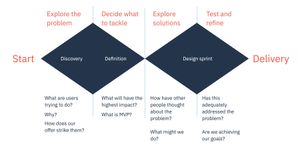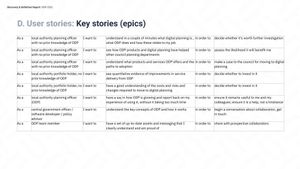First things first… understanding the terminology.
ODP 2022 is a communications project run collaboratively between Lambeth Council, 11 other councils, DLUHC, Open Systems Lab, Unboxed and Agile Collective. The term ODP refers to Open Digital Planning, a planning programme for council officers, which includes various services and products that work towards digitally transforming the planning sector.
It’s important to note that before we were able to provide a concise explanation of the project, we had to gather and sort through as much existing information as possible. This is known as the Discovery phase. This included consultations with both the project team and wider stakeholder groups in order to gain insight of the project and understand the problems we were aiming to tackle.
Once we’d gathered all of our learnings around ODP 2022, it was time to create a project plan. This is known as the Definition phase, where we simplify and synthesise our findings and converge on agreed outputs for the project. This method of working can be seen clearly in the Double Diamond diagram below.

Trust the Process.
Once we’d identified any risks and mitigations with the core-team during the project kick-off, it was time to get stuck in to the Theory of Change workshop, a space to work together to identify three main categories:
- Aims: what are we trying to achieve?
- Outcomes: what needs to be true for the aims to be met?
- Activities: The things we will actually do.
This session proved to be extremely insightful as we were able to identify the key audiences of the project, in order to outline and prioritise the aims. We devised a success criteria that allowed us to pinpoint primary, secondary and tertiary outcomes and finally we were able to decide on three activities that would both achieve the aims of the project and align with our success criteria.
Our main aim of the project is to talk to an audience that is not yet involved with ODP. Our intention is for them to adopt our products or the principles of digital planning. As such, we need to produce content that is most useful and convincing to them, and present it in the right channels at the right time.
To see the full list of aims, outcomes and activities see our Theory of Change.
Now that the Theory of Change had brought the key audience groups to light, it was time to really get into character and understand who they were and what they wanted. This is known as Audience typology. We developed a set of 80 user stories in the following format:
“As a Planning Officer (role), I want to read about new products and services on the horizon (need) so that I have something to look forward to and build momentum (goal).”
Once we had identified the needs and goals of each user group, we were able to prioritise them and extract the key stories (Epics). This information can be found in our User Story Backlog

So now we’ve identified what we’re trying to achieve, who we’re aiming this towards and how we will measure success - but how do we get there? The groups of activities that emerged from the Theory of Change represent the three streams of work in our project (or more concisely) our next steps.
What’s on the horizon?
Coming up in the ODP 2022 communication project, we have an excellent line up.
- Implement a communications strategy
- Devise a brand to identify ODP
- Design and build a website
So how does it all start? The next project phase we enter is the Design phase, during this process we will run two design sprints, using the model developed by Google Ventures. Sprint one will produce content and a strategy for ODP communications, sprint two will look closely at the website structure and functionality. As for the branding and identity of ODP, this will evolve alongside the website visual design.
A brief timeline
Now:
12 Sept - 10 Oct: Design Sprint
Next:
Oct - Nov: Specification, Brand release and Website build
Check out the full Discovery and Definition Phases Report here


